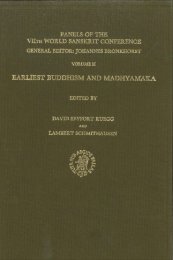The Buddhist Caves at Aurangabad - Wat Florida Dhammaram
The Buddhist Caves at Aurangabad - Wat Florida Dhammaram
The Buddhist Caves at Aurangabad - Wat Florida Dhammaram
Create successful ePaper yourself
Turn your PDF publications into a flip-book with our unique Google optimized e-Paper software.
the aurangabad renaissance in the fifth century 97<br />
Ajanta the Buddha is referred as munirāja or king of ascetics (Mirashi<br />
1963b, 127, verse 24).<br />
This tête à tête alludes to the concept th<strong>at</strong> both the Buddha and<br />
the king are cakravartins. Even if the local ruler did not fit the profile<br />
of the gre<strong>at</strong>est cakravartin of all times, Aśoka, the <strong>Buddhist</strong> liter<strong>at</strong>ure<br />
of this period of political fragment<strong>at</strong>ion seems to contain the notion<br />
th<strong>at</strong> different grad<strong>at</strong>ions of cakravartins could exist, based on the size<br />
of their kingdoms and on the means they used to expand it. In the<br />
Abhidharmakośa by Vasubandhu, a text <strong>at</strong>tributed to the l<strong>at</strong>e fourth<br />
to fifth century and possibly compiled in north India (Willemen et al.<br />
1998, 241), four kinds of cakravartins are listed: the golden, the silver,<br />
the copper, and the iron (Vallée Poussin 1923–25, 197 and 202).<br />
This <strong>Buddhist</strong> compendium possibly reflects the fifth century arena in<br />
which emerging local rulers, such as the p<strong>at</strong>rons of <strong>Aurangabad</strong> cave 3,<br />
became the new <strong>Buddhist</strong> elite in need of legitim<strong>at</strong>iz<strong>at</strong>ion.<br />
It is unclear whether the king and his entourage <strong>at</strong> <strong>Aurangabad</strong> are<br />
depicted in the act of performing a gift-giving ceremony specifically<br />
design<strong>at</strong>ed for royalty, or if they are just intent in an ordinary act of<br />
devotion such as offering a garland to the Buddha. 61 <strong>The</strong> presence of<br />
secular figures in the holiest of places raises an important question<br />
about the degree of public access granted to the laity in these caves.<br />
<strong>The</strong> prominence given to lay images inside the shrine of cave 3 and<br />
the fact th<strong>at</strong> so few monastic cells existed <strong>at</strong> <strong>Aurangabad</strong> would seem<br />
to indic<strong>at</strong>e th<strong>at</strong>, much as in the earliest phase of p<strong>at</strong>ronage, the caves<br />
continued to c<strong>at</strong>er more to the laity than to monastic members of the<br />
<strong>Buddhist</strong> community. Remarkably, the ritual involvement of the royal<br />
group seem to imply the notion of darśana: the king keeps his head up,<br />
in the direction of the Buddha, his eyes wide open to see the Buddha<br />
and be seen. <strong>The</strong>re has always been some hesitancy in recognizing th<strong>at</strong><br />
the practice of darśana, generally associ<strong>at</strong>ed with Hindu devotional<br />
ritual, was widely established in the <strong>Buddhist</strong> world early on. However<br />
the reliefs carved on the vedikā pillars of the Bharhut stūpa indic<strong>at</strong>e<br />
61 One of the main <strong>Buddhist</strong> celebr<strong>at</strong>ions associ<strong>at</strong>ed with kingship th<strong>at</strong> we know of<br />
is the quinquennial festival described in the Aśokāvadāna. (Strong 1989, 265–66). <strong>The</strong><br />
festival became an elabor<strong>at</strong>e celebr<strong>at</strong>ion in the medieval period, with the king taking<br />
on the appearance of a monk during the offering ceremony. This exchange of insignia<br />
between the Buddha and the ruler is depicted <strong>at</strong> Bamiyan in the niche of the 38-metretall<br />
Buddha (Klimburg-Salter 1989, 124). However, it is unlikely th<strong>at</strong> this particular<br />
celebr<strong>at</strong>ion is depicted in <strong>Aurangabad</strong> cave 3, where the donors are represented in<br />
their princely <strong>at</strong>tire.





